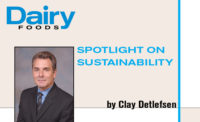Turning waste into energy
Dairy producers and processors have found value in what they used to throw away.

Many of my visits were quite memorable. In Michigan, Country Fresh impressed me with its emergency rescue system that was developed in response to OSHA’s promulgation of a confined-space entry rule. In St. Louis, I was impressed by the hospitality of Ice Cream Specialties and their encouragement of me to eat as many ice cream novelties as I wanted. Even though I was an adult I can tell you that was a kid-in-a-candy store moment.
Out west, I visited the Golden Cheese Co. of California. This was the first cheese plant I ever visited and my first exposure to deriving energy from waste. My recollection is that the plant was built in the 1980s as a response to the oil crisis of the 1970s. At that time it was envisioned that dairy processing waste, whey in particular, could be turned into energy in the form of ethanol. While I could be wrong in my recollection, I believe Golden Cheese of California’s operations were envisioned to produce ethanol as a primary product and cheese as a by-product. To say the least, I found the concept fascinating and was very impressed with what I saw.
A long time coming
When I left California I was sure that what I had just seen was the start of a movement that would take off at an amazing pace. Alternative energy from nonpetroleum sources was such a great idea. Sadly, I was wrong.
Fast forward about 20 years to the first Sustainability Summit in Bentonville, Ark., where again I felt the energy (or should I say excitement?) about alternative energy. This time the excitement was about dairy power on the farm: energy from methane digesters. I moderated a panel that included Dennis Haubenschild of Haubenschild Family Farms, Princeton, Minn., who spoke about the anaerobic digester he installed in the late 1990s.
While I have always been a fan of technology and a big fan of nonpetroleum based energy, I think what impressed me most was Dennis himself and his decision to pursue digester technology. Dennis knew it would be a challenge and that the road would have its fair share of bumps, but he quite simply summed up his decision as being the right thing to do. It was clear at the summit that digester technology was the right thing to do. It is finally starting to catch on for a variety of reasons.
In February of this year, the Innovation Center for U.S. Dairy released a report prepared by Informa Economics, entitled the “National Market Value of Anaerobic Digester Products.” Informa’s conclusion is that anaerobic digesters can be a profitable and sustainable solution for dairy operations.
What is different now — and what is changing the game — is the realization that additional and different waste streams from a variety of sources greatly enhance the production of methane and that it isn’t just the methane that has value. Haubenschild learned on his farm that using recycled newspaper bedding instead of straw resulted in significantly more methane production. He also learned that the end product digestate has value as a soil amendment.
A juicy milkshake from food waste
Others have discovered that combining dairy processing waste and wastewater with dairy farm waste yields a nice uptick in gas yield as well. Of particular interest these days is food waste generated at retail operations. Traditionally, that waste stream was destined for landfills. The Food Marketing Institute, which is a key player in the Food Waste Reduction Alliance Project, estimates that the re-use of food waste by conversion into energy could generate enough power to supply 16 million homes for a year. For a dairy producer, the acceptance of food waste may also create a revenue stream in the form of a tipping fee – the fee normally paid to a municipal solid waste facility for dumping. The national average for tipping fees is a little over $40 per ton of waste.
Farm-based digester technology is not the only option either. In May, the Los Angeles Times described Kroger’s entry into the digester game. The supermarket chain is taking food waste that cannot be donated from its Ralphs and Food 4 Less retail operations, mixing it with wastewater from its nearby creamery to create a “juicy milkshake” that is ultimately fed into a 2-million-gallon silo where it is digested and turned into 13 million kilowatt hours of electricity per year. Kroger is looking at other locations for similar installations.
Better gas yields, tipping fees, renewable energy and similar credits, and useful environmentally friendly by-products (like animal bedding, soil amendments and fertilizer) are changing the game, as are years of good experience and new developments with running and maintaining the digesters. And by the way, what is the national market value of anaerobic digester products? According to Informa, somewhere between $19 billion and $55 billion. Those figures are based only on farm systems, not the one that Kroger has put into operation.
Let’s keep the methane out of landfills and convert it into clean energy. The time has finally arrived.
Looking for a reprint of this article?
From high-res PDFs to custom plaques, order your copy today!









